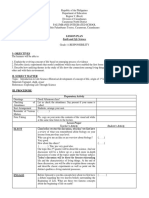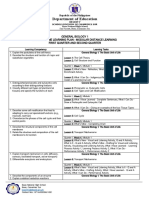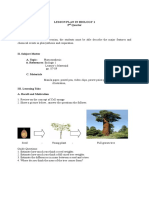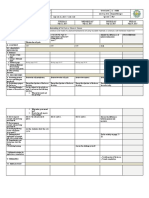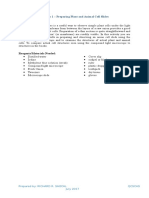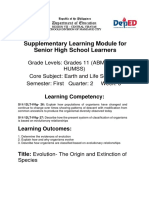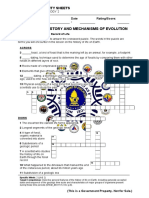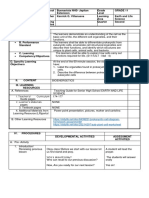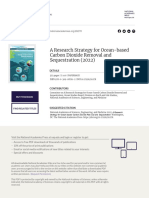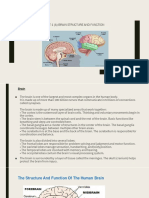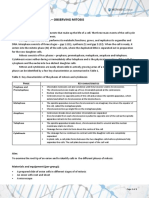IDEA GEN BIO 1 First Week
IDEA GEN BIO 1 First Week
Uploaded by
Cherrina AguilaOriginal Description:
Original Title
Copyright
Available Formats
Share this document
Did you find this document useful?
Is this content inappropriate?
Report this DocumentCopyright:
Available Formats
IDEA GEN BIO 1 First Week
IDEA GEN BIO 1 First Week
Uploaded by
Cherrina AguilaCopyright:
Available Formats
Learning Area General Biology I
Learning Delivery Modality Modular Distance Modality
School Sabang National HS Grade Level Grade 11
LESSON
Teacher Cherrina D. Aguila Learning Area General Biology I
Teaching Date ______________2020 Quarter First
EXEMPLAR Teaching Time 9:40 – 10:40 A.M. No. of Days 4 days
I. OBJECTIVES
At the end of the lesson, learners are expected to
1. Trace the beginnings of the discovery of the cell and the
development of the cell theory
2. a) Explain the Cell Theory
b) Describe the different parts of the cell and state its function
3. a) Be aware of how cellular structures play a vital role in body functions
b) Value the contributions made by several scientists toward the development of
cellular study
The learners demonstrate an understanding of …..
A. Content
1. Cell Theory
Standard
2. Cell Structure and Functions
B. Performance The learners shall be able to construct a 3D model of a plant/animal/bacterial cell
Standard using recyclable materials
STEM_BIO11/12-Ia-c-1: Explain the postulates of the cell theory
C. Most Essential Learning
Competencies (MELC) STEM_BIO11/12-Ia-c-2: Describe the structure and function of major and subcellular
organelles
D. Enabling Competencies
The Cell
II. Content 1. Cell Theory
2. Cell major parts and its subcellular organelles
III. Learning References
A. References
a. Teacher’s Guide Pages Teacher’s Guide p. 17 - 26
b. Learner’s Material Pages
1. General Biology I by Maria Angelica D. Rea p.
c. Textbook Pages
2. Biology by Carmelita Capco, pp. 155 – 164
d. Additional Materials from 1. https://www.slideshare.net/celltheory
Learning Resources 2. https://www.slideshare.net/cellparts
B. List of Learning Resources 1.Capco, C.M. (2003).Biology. Quezon City: Phoenix Publishing House
for Development and 2. http://www.youtube.com
Engagement Activities 3. http://www.slideshare.net
IV. PROCEDURES
A. Introduction What I need to know?
Learners take a diagnostic test to check their prior knowledge when they were
in Grade 7
The content of the lesson will be presented
Learning objectives will also be introduced to guide the learners on the
learning targets founded on KSAV principles
What’s new?
Like the leaf, the human body is also made up of cells. Can you imagine that
inside your body are about one hundred trillion cells? Through the years, new
techniques for studying cells and organisms have become possible.
Question: Do you wonder how the concept of cells become concrete?
TASK 1: IS IT TRUE?
Explain if the following quotes justify about the origin of life:
“Fireflies rise from the morning dew, fish and frogs from a muddy stew, maggot
worms from rotting meat and mice shall come from sweat and wheat.”
TASK 2: WHICH IS WHICH?
Look at the figure below. Analyze each flask. Which flask do you think demonstrates
the origin of life? Why do you say so?
A B C
--------------------------------------------------------------------------------------------------------
The previous figure explains that organisms or any living thing did not come out of
nothing. This was based from Francesco Redi’s experiments
to disprove Spontaneous Generation theory. Spontaneous Generation theory was the
theory that explains why living things came from nonliving things (as stated
previously on the previous quotes).
Because of Redi’s experiments, Spontaneous Generation theory was disproved to
explain the origin of life. Famous scientists/biologists had able to develop the cell
theory because of new techniques applied to study the concept of cells until they have
developed the Cell theory.
B. Development What I know?
TASK 4: Learners will explain why Spontaneous Generation theory proved to be
false
TASK 5: Learners write what do they know about cells or how did the cell theory was
developed.
What is it?
TRACING THE PAST
Read an outline of history on how cell theory was developed and how the structure and
cell parts have been discovered. (provided in the Module page _)
TASK 6: THE TIMELINE
Consider the timeline below:
Questions:
1. What three statements describe the cell theory?
2. When Hooke first used the term cell, did he intend to have it apply to living
material? Explain your answer.
3. What do you think were the evidences when Virchow postulated that all new cells
arise from existing cells?
4. How did Virchow’s idea contributed to the formation of cell theory?
5. How significant the use of microscope is in formulating the Cell theory?
CELL PARTS AND ITS FUNCTION
Read the different parts of the cell and its function (Provided in the LM, page _____)
TASK 7: Describe each cell part and cite how it functions.
1. Cell membrane
2. Nucleus
3. Cytoplasm
4. Mitochondria
5. Lysosome
6. Endoplasmic reticulum and its types
7. Golgi bodies
8. Lysosome
9. chloroplast
10. Cell wall
C. Engagement What’s more?
TASK 8: Make a Comparison
Compare the cell and its parts to a school. Relate how important each part to maintain
the school’s system in making the learners safe with an environment conducive for
learning.
What can I do?
TASK 9: Learning the different cell parts and its function, choose an organelle that
you think has a vital role to maintain cell’s system. Explain why you think this part is
vital to the cell.
What other enrichment activities can I engage in?
TASK 10:
1. Learners do a little research on some new discoveries about the cell. Write their
findings.
2. Learners do a little research on some modern equipment used to study cells. Write
their findings.
What have I learned?
TASK 11: Using differentiated instruction
Based on the interest of the learner/s, let each learner show their appreciation from
the contributions of the scientists that helped developed the concept of the cell theory
and its discovery of the cell parts. They may choose any of the following as their
output:
1. essay writing
2. poem writing
D. Assimilation 3. creating a jingle
4. poster making
5. speech delivery (can be uploaded via gc or google classroom)
6. short video presentation (can be submitted vis usb or online)
What can I do?
The learners will answer the Assessment provided in the module.
The learners in their notebook, journal or portfolio will write their personal insights
about the lesson using the prompts below.
V. REFLECTION
I understand that _________________________________________________
I realize that ______________________________________________________
Prepared and Submitted by
CHERRINA D. AGUILA
SST – III
Submitted to
FLORDELIZA C. PATIÑO
Principal I
You might also like
- 2nd Quarter FINAL EXAM General Biology 1Document2 pages2nd Quarter FINAL EXAM General Biology 1Cherrina Aguila71% (7)
- Summative Test Week 1 - 4 Practical Research 2Document2 pagesSummative Test Week 1 - 4 Practical Research 2Cherrina AguilaNoch keine Bewertungen
- Whole Brain Learning System Outcome-Based Education: General Biology 1Document9 pagesWhole Brain Learning System Outcome-Based Education: General Biology 1Rei-Rei RamosNoch keine Bewertungen
- General Instruction: Please Avoid Erasures Any Form of Erasures Are Not CountedDocument4 pagesGeneral Instruction: Please Avoid Erasures Any Form of Erasures Are Not CountedCherrina AguilaNoch keine Bewertungen
- 2nd Week IDEA GEN BIO 1Document5 pages2nd Week IDEA GEN BIO 1Cherrina AguilaNoch keine Bewertungen
- Day 1-Cell Theory - 7esDocument7 pagesDay 1-Cell Theory - 7esSheryl Lou AngelesNoch keine Bewertungen
- DLL Shs Stem Grade 12general Biology1 Quarter1 Week1 Palawan Division 1 PDF FreeDocument13 pagesDLL Shs Stem Grade 12general Biology1 Quarter1 Week1 Palawan Division 1 PDF FreeJinky AydallaNoch keine Bewertungen
- BIOLOGY Q1 Mod1Document30 pagesBIOLOGY Q1 Mod1Karen Mae CastilloNoch keine Bewertungen
- LP1 The Cell TheoryDocument3 pagesLP1 The Cell TheoryPaulus VillanuevaNoch keine Bewertungen
- DLL SHS STEM Grade 12 - General Biology1 Quarter1 Week2 (Palawan Division)Document17 pagesDLL SHS STEM Grade 12 - General Biology1 Quarter1 Week2 (Palawan Division)Ann Quirante100% (3)
- DLL Bio 1Document4 pagesDLL Bio 1Anonymous Dtsv6ySI100% (1)
- S11ES Ie 12Document3 pagesS11ES Ie 12allanrnmanalotoNoch keine Bewertungen
- GB2 LAS Q3 W2 Evol of Life On EarthDocument14 pagesGB2 LAS Q3 W2 Evol of Life On EarthAnn Clarisse Ondiano100% (1)
- New DLL SHS - General Biology 1 June 12-16, 2017-2018Document2 pagesNew DLL SHS - General Biology 1 June 12-16, 2017-2018BeeWinNoch keine Bewertungen
- 11-16-15 Cell Theory Lesson PlanDocument5 pages11-16-15 Cell Theory Lesson Planapi-292269738Noch keine Bewertungen
- Earth and Life Science: Lesson PlanDocument21 pagesEarth and Life Science: Lesson PlanBorbe ClauNoch keine Bewertungen
- Gen Bio 1 DLLDocument5 pagesGen Bio 1 DLLViviane O. BaylonNoch keine Bewertungen
- General Biology1 WHLP-1Document3 pagesGeneral Biology1 WHLP-1Angelika BernalNoch keine Bewertungen
- 1 DLL Gen Bio 1Document3 pages1 DLL Gen Bio 1marizel salcedo100% (1)
- Lesson Plan in Biology 1 2 QuarterDocument3 pagesLesson Plan in Biology 1 2 QuarterLieshaNoch keine Bewertungen
- Performance Task 1 Gen BioDocument1 pagePerformance Task 1 Gen BioKennedy Fieldad VagayNoch keine Bewertungen
- Biology Grade 11 3rd Quarter DLLDocument21 pagesBiology Grade 11 3rd Quarter DLLkyru Schatten100% (1)
- Lesson Guide in Earth and Life Science I. ObjectivesDocument4 pagesLesson Guide in Earth and Life Science I. ObjectivesJT SaguinNoch keine Bewertungen
- Biology 1 and 2 K12Document12 pagesBiology 1 and 2 K12ewwwNoch keine Bewertungen
- Learning Activity Sheet in Biology 1: Quarter 1 Week 1Document10 pagesLearning Activity Sheet in Biology 1: Quarter 1 Week 1Ryan Negad100% (1)
- Detailed Lesson Plan in General Biology 2Document2 pagesDetailed Lesson Plan in General Biology 2brinda100% (1)
- Lesson 2 - Prokaryotic VS Eukaryotic CellsDocument3 pagesLesson 2 - Prokaryotic VS Eukaryotic CellsEarl Caesar Quiba Pagunsan100% (1)
- Gen Bio 1 Lesson 4Document2 pagesGen Bio 1 Lesson 4Ric Santos100% (1)
- New DLL SHS - General Biology 1 July 10-14, 2017-2018Document2 pagesNew DLL SHS - General Biology 1 July 10-14, 2017-2018BeeWin100% (1)
- Parts of The Cell PDFDocument2 pagesParts of The Cell PDFArafat DalumaNoch keine Bewertungen
- Demo Lesson Plan General BiologyDocument3 pagesDemo Lesson Plan General BiologyMichelle Ann C. DegranNoch keine Bewertungen
- WHLP Gen Bio 1 Week 5Document2 pagesWHLP Gen Bio 1 Week 5Marianne GonzalesNoch keine Bewertungen
- Activity 1 - Preparing Plant and Animal Cell SlidesDocument4 pagesActivity 1 - Preparing Plant and Animal Cell Slidesjilmorata2Noch keine Bewertungen
- Quiz 2-Concept of LifeDocument1 pageQuiz 2-Concept of LifeMichael Paul Sinsuan100% (2)
- DLP GlycolysisDocument3 pagesDLP GlycolysisMichelle NicolasNoch keine Bewertungen
- New DLL SHS - General Biology 1 June 26-30, 2017-2018Document2 pagesNew DLL SHS - General Biology 1 June 26-30, 2017-2018BeeWinNoch keine Bewertungen
- General Biology 1 Module 6Document19 pagesGeneral Biology 1 Module 6Vienne MonroidNoch keine Bewertungen
- General Biology 2 DLL October 01 and October 02 2018Document4 pagesGeneral Biology 2 DLL October 01 and October 02 2018Ivy AguasNoch keine Bewertungen
- Syllabus in Biological ScienceDocument8 pagesSyllabus in Biological ScienceCJ DaodaoenNoch keine Bewertungen
- DLP Gas Exchange in Plants and Animals - Q4 WK4 COT SAN CARLOS DIVISIONDocument8 pagesDLP Gas Exchange in Plants and Animals - Q4 WK4 COT SAN CARLOS DIVISIONjulzhaide100% (1)
- New DLL SHS - General Biology 1 June 19-23, 2017-2018Document2 pagesNew DLL SHS - General Biology 1 June 19-23, 2017-2018BeeWin100% (1)
- New DLL SHS - General Biology 1 June 12-16, 2017-2018Document2 pagesNew DLL SHS - General Biology 1 June 12-16, 2017-2018BeeWinNoch keine Bewertungen
- Wake Up, Eat Breakfast and Get Ready For The Scheduled LessonsDocument2 pagesWake Up, Eat Breakfast and Get Ready For The Scheduled LessonsMarianne GonzalesNoch keine Bewertungen
- Intro To LifeDocument32 pagesIntro To LifeMaricar Paz100% (1)
- WEEK 2.1 LAS General Biology Q1Document4 pagesWEEK 2.1 LAS General Biology Q1Joshua EsguerraNoch keine Bewertungen
- Earth and Life Science Q2 Module 8 EvolutionDocument19 pagesEarth and Life Science Q2 Module 8 EvolutionMarc Joseph NillasNoch keine Bewertungen
- General Biology 1 WHLP Week 1 2Document4 pagesGeneral Biology 1 WHLP Week 1 2maryNoch keine Bewertungen
- Toaz - Info DLL Shs Stem Grade 12 General Biology1 Quarter1 Week1 Palawan Division 1 PRDocument13 pagesToaz - Info DLL Shs Stem Grade 12 General Biology1 Quarter1 Week1 Palawan Division 1 PRNoemi DenostaNoch keine Bewertungen
- Asexual ReproductionDocument20 pagesAsexual ReproductionAxestetikriey HalesNoch keine Bewertungen
- General Biology 1 Stem 12: Test L. Multiple Choice. Encircle The Letter of The Correct AnswerDocument3 pagesGeneral Biology 1 Stem 12: Test L. Multiple Choice. Encircle The Letter of The Correct AnswerJohnson FernandezNoch keine Bewertungen
- STEM Genbio11 q1 SLM Mod Cell-Structures-and-FunctionsDocument28 pagesSTEM Genbio11 q1 SLM Mod Cell-Structures-and-FunctionsLouie BarrientosNoch keine Bewertungen
- Biology 2 Las 2 Maria Carmina R Martin Version 4Document4 pagesBiology 2 Las 2 Maria Carmina R Martin Version 4FEMALE Dawal LaizaNoch keine Bewertungen
- Activity-Sexual and Asexual Reproduction-Grade 7Document22 pagesActivity-Sexual and Asexual Reproduction-Grade 7ireneNoch keine Bewertungen
- Chemical and Nervous Control Part 1 T.GDocument5 pagesChemical and Nervous Control Part 1 T.GMarichu Cayabyab100% (2)
- New DLL SHS - General Biology 1 July 17-21, 2017-2018Document2 pagesNew DLL SHS - General Biology 1 July 17-21, 2017-2018BeeWinNoch keine Bewertungen
- DLP - Day 4 (Cell)Document3 pagesDLP - Day 4 (Cell)kenrick09100% (1)
- Bio June 10-14Document3 pagesBio June 10-14Jamoi Ray VedastoNoch keine Bewertungen
- Unit 4 Compare and Contrast Process in Plants and Animals: Nutrient Procurement and ProcessingDocument8 pagesUnit 4 Compare and Contrast Process in Plants and Animals: Nutrient Procurement and ProcessingPh4nt0mNoch keine Bewertungen
- Asexual and Sexual ReproductionDocument14 pagesAsexual and Sexual ReproductionJazel SalesNoch keine Bewertungen
- Cell OrganellesDocument3 pagesCell OrganellesYamyang Galay-BañoNoch keine Bewertungen
- General Biology-Q2-Week 2Document15 pagesGeneral Biology-Q2-Week 2ALFREDO CALEDANoch keine Bewertungen
- 4 Sep CellDocument5 pages4 Sep CellARCHIBALD S. SALANGSANGNoch keine Bewertungen
- Biotech Module 1 1Document49 pagesBiotech Module 1 1Janine CallanganNoch keine Bewertungen
- Mrtena Manuscript For DefenseDocument104 pagesMrtena Manuscript For DefenseCherrina AguilaNoch keine Bewertungen
- 2nd Quarter FINAL EXAM Introduction To The Human PhilosophyDocument2 pages2nd Quarter FINAL EXAM Introduction To The Human PhilosophyCherrina AguilaNoch keine Bewertungen
- 2nd Quarter FINAL EXAM Practical Research 2Document3 pages2nd Quarter FINAL EXAM Practical Research 2Cherrina AguilaNoch keine Bewertungen
- Summative Test Week 1 - 4 P.EDocument2 pagesSummative Test Week 1 - 4 P.ECherrina AguilaNoch keine Bewertungen
- Intro To Philosophy Summative Assessment Week 1 - 4Document1 pageIntro To Philosophy Summative Assessment Week 1 - 4Cherrina Aguila100% (1)
- 2nd Quarter FINAL EXAM Earth and Life ScienceDocument3 pages2nd Quarter FINAL EXAM Earth and Life ScienceCherrina Aguila100% (2)
- Summative Test Week 1 - 4 Media and Info LiteracyDocument2 pagesSummative Test Week 1 - 4 Media and Info LiteracyCherrina Aguila100% (1)
- Summative Test Week 1 - 4 Earth and Life ScienceDocument2 pagesSummative Test Week 1 - 4 Earth and Life ScienceCherrina AguilaNoch keine Bewertungen
- Learning Area Earth Science Learning Delivery Modality Modular Distance ModalityDocument5 pagesLearning Area Earth Science Learning Delivery Modality Modular Distance ModalityCherrina AguilaNoch keine Bewertungen
- General Biology 1 Summative Assessment Week 1-4Document2 pagesGeneral Biology 1 Summative Assessment Week 1-4Cherrina Aguila100% (1)
- Department of Education: Republic of The PhilippinesDocument5 pagesDepartment of Education: Republic of The PhilippinesCherrina AguilaNoch keine Bewertungen
- Biology 2 Module 7Document5 pagesBiology 2 Module 7Cherrina AguilaNoch keine Bewertungen
- Department of Education: Republic of The PhilippinesDocument2 pagesDepartment of Education: Republic of The PhilippinesCherrina AguilaNoch keine Bewertungen
- MEDIA AND INFO LIT Learning Activity Sheet #1Document3 pagesMEDIA AND INFO LIT Learning Activity Sheet #1Cherrina Aguila100% (4)
- General Instruction: Please Avoid Erasures. Any Form of Erasures Are Not CountedDocument5 pagesGeneral Instruction: Please Avoid Erasures. Any Form of Erasures Are Not CountedCherrina AguilaNoch keine Bewertungen
- Philippine National ArtistsDocument4 pagesPhilippine National ArtistsCherrina AguilaNoch keine Bewertungen
- Ge5 Module 16Document13 pagesGe5 Module 16Cinderella MateoNoch keine Bewertungen
- 04 Plant Taxonomy ManualDocument56 pages04 Plant Taxonomy ManualCapale MCNoch keine Bewertungen
- PreviewpdfDocument103 pagesPreviewpdfHarsh ChordiyaNoch keine Bewertungen
- Who Transforms Solutions? - : We DoDocument13 pagesWho Transforms Solutions? - : We Docontentdrive4 drive4Noch keine Bewertungen
- EIAR 50TH Fishery Manuscript (Aschalew Et Al) AsDocument27 pagesEIAR 50TH Fishery Manuscript (Aschalew Et Al) AsYared FikaduNoch keine Bewertungen
- Medical Equipment Management - WikipediaDocument1 pageMedical Equipment Management - WikipediaEzanaNoch keine Bewertungen
- Coleoptera PDFDocument403 pagesColeoptera PDFLenny Mae JagosNoch keine Bewertungen
- The Ecology of Rafting in The Marine Environment PDFDocument84 pagesThe Ecology of Rafting in The Marine Environment PDFazmialviangNoch keine Bewertungen
- A Research Strategy For Ocean-Based Carbon Dioxide Removal and Sequestration (2021)Document323 pagesA Research Strategy For Ocean-Based Carbon Dioxide Removal and Sequestration (2021)MargoNoch keine Bewertungen
- A VTCT (ITEC) Sports Massage - Level 3 Feb 2020Document114 pagesA VTCT (ITEC) Sports Massage - Level 3 Feb 2020Ray Morgan Sport and FitnessNoch keine Bewertungen
- H01 Homeostasis - PPT SlidesDocument18 pagesH01 Homeostasis - PPT SlidesSanaaNoch keine Bewertungen
- Venn Diagram On Osmosis and DiffusionDocument1 pageVenn Diagram On Osmosis and DiffusioncolacastellNoch keine Bewertungen
- Vp-Green Vale Academy, Inc.: Curriculum Map GRADE: 10 SUBJECT: ScienceDocument5 pagesVp-Green Vale Academy, Inc.: Curriculum Map GRADE: 10 SUBJECT: ScienceRegina Minguez Sabanal100% (1)
- Motor Control Theories and PhysiologyDocument7 pagesMotor Control Theories and PhysiologyAaminah NawazNoch keine Bewertungen
- Hair As Evidence: Scale PatternsDocument3 pagesHair As Evidence: Scale PatternsMegan FarrenNoch keine Bewertungen
- General EducationDocument17 pagesGeneral EducationDyna PanizalesNoch keine Bewertungen
- Clio Cresswell PHD ThesisDocument6 pagesClio Cresswell PHD ThesisDaniel Wachtel100% (2)
- Human Tissues and Its FunctionsDocument1 pageHuman Tissues and Its FunctionsJnnfr BautistaNoch keine Bewertungen
- Activity 2 Intro Tissue SectioningDocument4 pagesActivity 2 Intro Tissue SectioningEricka GenoveNoch keine Bewertungen
- Short Day Effects On A Long Day Plant Solanum LycopersicumDocument3 pagesShort Day Effects On A Long Day Plant Solanum LycopersicumInternational Journal of Innovative Science and Research TechnologyNoch keine Bewertungen
- Databases in Bioinformatics - An IntroductionDocument11 pagesDatabases in Bioinformatics - An IntroductionIsha ChopraNoch keine Bewertungen
- Unit 1 (A) Brain Structure and FunctionDocument6 pagesUnit 1 (A) Brain Structure and FunctionAvni SinghNoch keine Bewertungen
- MSC Nursing Written Assignment GuidelinesDocument4 pagesMSC Nursing Written Assignment GuidelinesJEEJANoch keine Bewertungen
- 1 - Observing Mitosis First Hand Data Exercise PDFDocument2 pages1 - Observing Mitosis First Hand Data Exercise PDFLloaana 12Noch keine Bewertungen
- Tendon Transfers: by DR Krishna BhattDocument89 pagesTendon Transfers: by DR Krishna Bhattvenkata ramakrishnaiahNoch keine Bewertungen
- Zhao Et Al 2021 Pentatoma Rufipes MitogenomeDocument22 pagesZhao Et Al 2021 Pentatoma Rufipes MitogenomeDávid RédeiNoch keine Bewertungen
- Science P5 Revision Unit 9Document4 pagesScience P5 Revision Unit 9starsschooljktNoch keine Bewertungen
- BORI FinalDocument14 pagesBORI FinalTanvir HossainNoch keine Bewertungen
- The Role of Language in The Cognitive Sciences: January 2020Document25 pagesThe Role of Language in The Cognitive Sciences: January 2020Mhmmd AbdNoch keine Bewertungen
- Marginal Adaptation and Sealing Ability EvaluationDocument8 pagesMarginal Adaptation and Sealing Ability EvaluationMarwa Wagih ElboraeyNoch keine Bewertungen















